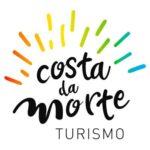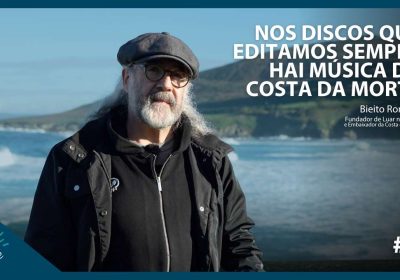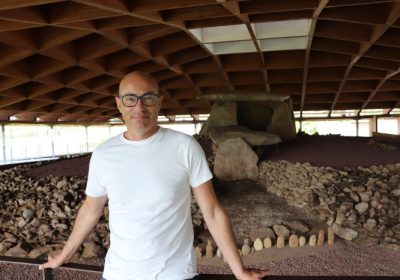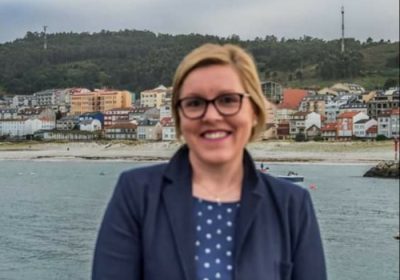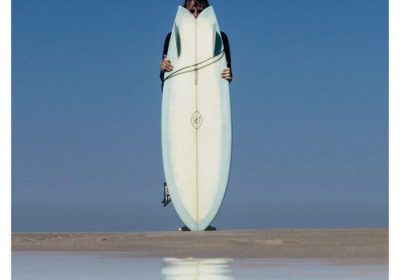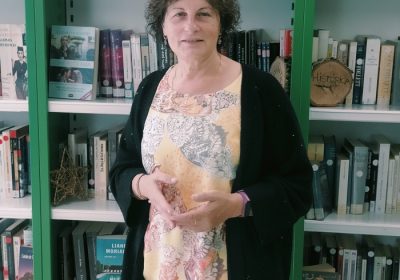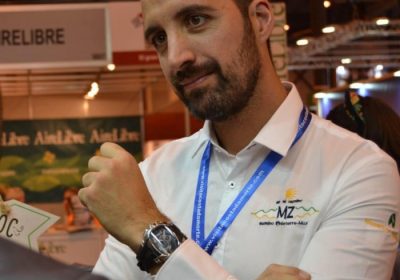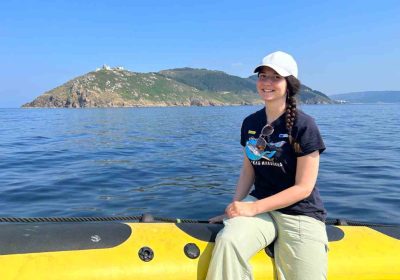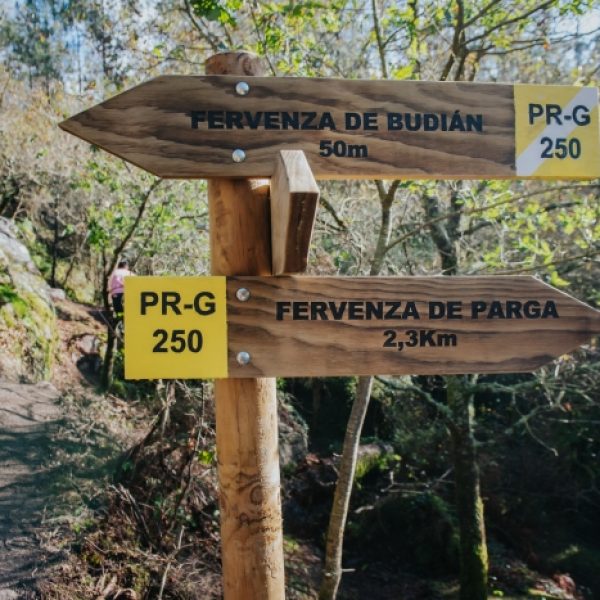We continue with the interviews to the town councils with the Town Council of Corcubión. Corcubión is located in Galicia, the current Spanish Autonomous Community located in the northwest of the Iberian Peninsula, where the Roman Gallaecia was formerly located and later, between 409 and 1833, the Kingdom of Galicia.
Galicia also belongs to the Galicia-North Portugal Euroregion.
The Ría de Corcubión, where the mythical cape of Fisterra is located, is the highest of the Rías Baixas and forms part of the so-called Costa da Morte. The easiest way to get to Corcubión is from Santiago de Compostela (capital of Galicia) or from A Coruña.
Today we show you the town council from the point of view of Patricia Trasmonde Martínez, Tourism Technician. She was born in Corcubión, although her parents are not from this municipality, but from the municipality of Muxía. She is the youngest of four siblings and the only one of them born in Corcubión. As many other neighbours of the Costa da Morte, her parents emigrated to Switzerland where they stayed for a few years to return to their land, choosing Corcubión as their place of residence and where they opened their business, a small supermarket where they worked for 30 years.
It was in Corcubión where he grew up, until he left to study in Vigo at the age of 18. After a year in this city he moved to La Coruña to study a Diploma in Tourism, finishing it in 2010, after a 5 month stay at the Instituto Superior de Línguas y Administração, in Lisbon. Shortly after, she studied a Master’s Degree in Teaching at the University of A Coruña in order to prepare for a competitive examination and to be able to dedicate herself one day to teaching (something she had a predilection for since she was a child). Subsequently, she also studied a Master’s Degree in Planning and Management of Tourist Destinations and Products, also at the University of A Coruña.
Between 2011 and 2016 she lived in A Coruña working outside the field of tourism, in an occupation that allowed her to work and study at the same time. In 2016 he returned to Corcubión to stay. She was lucky enough to be able to start working in the summer of 2016 as a Tourism Technician in the City Council of Corcubión and, luckily, except for the year 2019, she continued the rest of the years until the current one in the same position (although not continuously).
Her functions in this job are those of attention to visitors and pilgrims in the Tourist Office of the town, carrying out the own tasks of the same as they are the attention in person, telephone and by email so much of visitors and pilgrims or any other person who wants to consult some type of information; the elaboration of statistics, of informative material, of the schedules of bus, of museums, of the establishments of lodging and restoration…. Everything related to providing information about her municipality as well as the other municipalities that make up the Costa da Morte, as well as working on the cultural dissemination activities of her Town Council, such as the design and implementation of guided tours of the historic-artistic site of Corcubión, which have been carried out since 2018.
We leave you their best answers:
What feelings does Costa da Morte arouse in you? What does it mean to you?
For me, Costa da Morte means quality of life. Even more so when, as in my case, you have children. To be able to grow up here is a privilege. On a personal level, after living in the cities of Vigo, A Coruña and Lisbon for my studies and in A Coruña for my work, I would not change Corcubión and Costa da Morte for life in a city. And even more so when in Corcubión and Cee we have all the services available and A Coruña and Santiago de Compostela are only an hour’s drive away.
Costa da Morte is, as I said, quality of life. But it is also tranquillity, peace, calm, family, friends, homesickness? On a personal level, I remember how in my student days, when Friday arrived, the ritual was, once classes were over, to take the road back home for the weekend. And the same thing happened in my immediate environment: the weekend was to be at home, with family and friends. This is something that can still be seen today: with the exception of the summer (especially the months of July and August, when we have more visitors and we see that the population increases in our villages) the rest of the year during the week there is not too much movement in the village, but from Friday to Sunday we have an atmosphere in the village that is not only due to the fact that these are the days when people are more free from their work, but also because neighbours of Corcubión, due to studies and work are outside the village, return to it at the weekends or when their duties allow them to do so. And let’s not talk about the summer… with all the festivals that are all over Costa da Morte (I’m talking about before COVID-19), highlighting, for me, the country festivals.
Personally, Costa da Morte for me is synonymous with home.
Three reasons to discover it
- Gastronomy
- Landscape.
- Disconnection from routine.
What time of the year do you like Costa da Morte the most and why?
I like it at any time of the year, but I’m not much of a beach person, so I like it more in autumn and spring, or even in winter rather than in summer. I don’t mean that I don’t like it in summer, which I do like because the temperature is much more pleasant, because it’s the time of the summer when there are more fiestas (of which I like the countryside ones the most) and because the days are longer and you can make the most of them to visit places, go on routes or have a drink/dinner on a terrace. But autumn, for me, is a quieter time of the year, a nice time to go on a walking route anywhere on the Costa da Morte, there are no more crowds in the most popular places… And for me, who now goes with a child who is not yet 3 years old to all the places, I would say that it is the best time to walk along the Costa da Morte because of the tranquillity it offers us.
For tourists who come to visit you outside the summer season, what experiences are not to be missed?
- A walking route through the natural areas of any of the municipalities of the Costa da Morte.
- Tasting a good Galician stew on a winter’s day.
- A stroll through the historic centre of Corcubión.
- Even on windy days or if there is a storm, it is very nice to see the sea break on the coast of Muxía.
- Watching the sunset.
Besides the Isla Lobeira lighthouse, what other places or experiences are not to be missed?
- A sunset from Redonda.
- A walk from the church of San Pedro de Redonda to Cabo de la Nasa, where you can see Cape Fisterra, Lobeira Island or the Carrumeiro Chico lighthouse.
- A tour around the outskirts of the town of Corcubión, from where you can appreciate a good view of the Corcubión estuary.
Galicia in general, and Costa da Morte in particular, are synonymous with good food. Do you have any recommendations of typical dishes to discover Corcubión through the palate?
In the restaurants of Corcubión we can taste delicious fish and seafood dishes, something common in all the villages of Costa da Morte. But we can also enjoy a tasty potato omelette and other dishes such as octopus á feira, fried squid or raxo and zorza. And many more things that are sure not to disappoint, such as a stew or the ears and filloas of Carnival. If here for eating… we eat very well!
What do the people who visit you tell you? What do they like the most about their stay in Corcubión? And about Costa da Morte?
In general they comment how beautiful the whole Costa da Morte is, the beautiful beaches we have and the impressive views that can be seen from many of the places they visit. The subject of gastronomy is also worth mentioning, as all our visitors agree in highlighting the good gastronomy we have, how well they eat in general and the good quality-price ratio of the establishments of the Costa da Morte.
Of Corcubión they emphasize how beautiful is the entrance in the village, bordering the estuary that is full of small boats. And all of them emphasize how marvellous is the Church of San Marcos as well as the different stately houses that can be seen when touring Corcubión. In general, they agree that Corcubión has a well preserved historical complex and, despite being one of the smallest towns, they think that it is the most charming as a whole.
What are your three favourite beaches on the Costa da Morte, why those, and for surfing and other water sports activities?
Personally, and due to my situation, my favourite is Quenxe, in Corcubión, because in my case, and living here with a 2 year old child, it is the one I can reach walking in 10 minutes from the centre of the town, taking advantage of the promenade and without the need to take the car. Moreover, it is a very sheltered estuary beach that is safe to go with small children.
Another one that I like is Estorde, also for its proximity to Corcubión or Gures, which on windy days is very sheltered. Although these beaches are very beautiful and are very good for bathing it is difficult to say which are the favourites or to choose three, because we have many very beautiful beaches to which to be able to go although they are more dangerous for bathing, as for example the Beach of the Face.
I would highlight all of them: Carnota beach, Nemiña beach, Los Molinos, Trece, Traba de Laxe… and I would go on with the list, because they all have their charm.
For surfing I would highlight Nemiña beach, although it is also practised in Mar de Fóra and further up in Carballo, in Razo.
For those who love hiking… Which one do you recommend in your municipality and which is your favourite one in Costa da Morte?
In Corcubión, the one I do most often is the route that goes from Corcubión along the promenade to Quenxe, from there to the Lighthouse of Corcubión, La Redonda and El Vilar, and then back to the town, going down from El Vilar along the Way of St. James to Fisterra (in the opposite direction).
Another one that I like close to Corcubión is the Meigha Lirea, which starts in Lires (Cee). And of course, the ascent to Monte Pindo from O Fieiro. I also have pending to do the Route of the water of Zas, very recommended by acquaintances that already did it and which I have in the list of pending things.
What place do you think is the great unknown in Costa da Morte but has a great interest or potential?
Within the municipality of Corcubión I would say that it is the coastal area between the Cape Lighthouse, Cee and Redonda and Amarela that can be done on foot, although at the moment there is no signposted itinerary. What I mean by this is that Corcubión is better known for its historical-artistic complex and those who visit the town come more with the idea of seeing its historical part, but also in our municipality we have a part of the coast that can be done on foot and that, in general, is not as well known as other coastal areas in the surrounding areas.
Generally speaking, I think that the most unknown areas of Costa da Morte are the inland municipalities. At least that is the feeling I get from the visitors who pass through Corcubión and who demand more to see coastal places and do routes by the sea, when in many inland places there are beautiful landscapes with small waterfalls and paths to do on foot (Mazaricos, Zas, Coristanco, Carballo…) or river walks like the one in Gabenlle, in A Laracha. This is my opinion based on the people who ask for information in the Tourist Office of Corcubión.
Where do we find the best sunset?
Being Cabo Touriñán the most westerly point it is highly recommended to see the sunset from there. My experience there was fantastic, on a late summer afternoon and with very few people (there would be 4 cars, no more). A place with an unbeatable tranquillity and landscape.
Without taking away merit to other places, such as Cabo Fisterra or Lires, from where you can also see a wonderful sunset, also in Corcubión we have the Lugar de Redonda from where to see the sunset is something that is advisable to experience.
